Mechanical keyboards have been around as long as PC keyboards have, even if the larger portion of the population only became aware of their existence in recent years. Decades-old historical icons like the IBM Model M keyboard defined the solid-feeling, reliable, and extremely long-lasting reputation keyboards of this type retail to this day. They also created the love-it-or-hate-it “clicky” sound many early boards, and some modern ones, produce when typing.
Modern mechanical keyboards have become incredibly diverse. They can provide everything from that vintage clicky sound, to dead-silent typing and ship in form factors as small as 40% and as large as full-sized and above. Boards are available now to suit everyone from hardcore gamers to the most straight-laced, business-focused office worker. While the most particular mechanical keyboard hobbyists may want to build their own boards (or at least heavily modify an existing board), the larger portion of the potential user base will likely opt for a solution that’s both excellent out of the box and can also be tinkered with down the road.
To help you find the best pre-made options for those that just want to get clacking away and those that are unsure how deep their interest goes, we’ve rounded up a list of some of the best options on the market today. This list will focus on readily-available, mass produced boards. While there are some exceptional small-batch boards out there, they tend to be far more expensive and very often out of stock. The entries below represent the absolute best boards you can actually get your hands on without taking out a second mortgage.
While each one of these entries will include a brief descriptor of its most ideal user, don’t let that restrict your purchasing options. “Gamer” aesthetics like RGB lights can always be turned off, and non-gaming keyboards can be just as adept at competitive gameplay with the right switches and software. Instead, focus on your budget, desk space, and the available switch options you’d prefer.
Keychron K8 Wireless
Best mechanical keyboard overall: A budget-friendly entry point for gamers, typists, and hobbyists
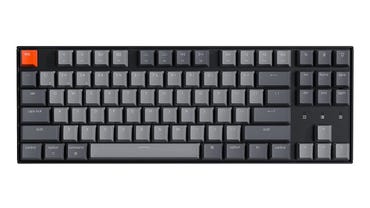
Features
- Form factor – Tenkeyless
- Connection type – Wireless (Bluetooth) or Wired (USB-C to USB-A)
- Available switch types – Blue (clicky), Brown (tacticle), or Red (linear)
- Hot swappable switch sockets – Yes
I’ve raved about the Keychron K8 series as the ideal entry point to the mechanical keyboard hobby in my review of the product. It remains one of the best boards out there for those just starting out. It offers a lineup of features typically only found in far more expensive boards from other manufacturers, including RGB lighting, hot swap switch sockets, stable Bluetooth connectivity, and an epic battery life.
The version I’ve featured here is the model with a plastic case, RGB backlighting, and hot swap sockets. These sockets allow mech key beginners to use the board as a platform to experiment with the massive variety of mechanical keyboard switches on the market today, all with slightly different tactile characteristics, sound profiles, and features. The extremely customizable lighting also allows it to be as flashy or as subdued as you’d like.
I chose the “tenkeyless” K8, which doesn’t include the right-side number pad, for its excellent balance of providing every key you might need for serious text editing while also saving some space that would be taken up by a full-sized board. Thankfully, if you’d prefer more space-saving at the cost of a few more keys, or you’d rather have a full-sized board, Keychron’s got you covered with very similar models in 60%, 100%, and even non-standard 65% and 75% form factors.
Pros
- Inexpensive and well-built
- Hot swap sockets allow for limitless customizability down the road
- Wired and wireless connection options add versatility
- RGB lighting can add gamer flare or simple, practical backlighting
Cons
- Included keycaps are of middling quality
- Battery-saving automatic standby takes getting used to
- Plastic case doesn’t look as premium as some other options here
Razer Huntsman Mini
Best small form factor mechanical keyboard: Designed for gamers and anyone with limited desk space
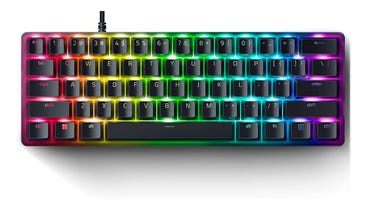
Features
- Form factor – 60%
- Connection type – Wired (USB-A)
- Available switch types – Purple (clicky), Red (linear), or Analog
- Hot swappable switch sockets – No
Razer’s reputation for quality-built products has waxed and waned over the years. However, the company has recently been on a streak of releasing high-quality, well-built, and reasonably priced peripherals that have brought back a huge following in the gaming community, as well as those outside of it that appreciate the low costs and excellent customizability offered.
More: Razer Blackshark V2 Pro headset review: A potent weapon for the right gamer | Razer Pro Type Ultra, Click Mini, and Glide XXL review: Gaming the office system
The Huntsman Mini is the latest entry in the Huntsman gaming keyboard line, opting for the diminutive 60% form factor. This means that the text editing cluster and arrow keys found on tenkeyless and full-sized boards are not included. While most of these keys are still available by using the included “fn” modifier key, they’re far less convenient to access. For this reason, this keyboard is the only one on the list I’d strongly recommend exclusively for gamers that don’t intend to do heavy text editing on the same PC they game on.
As long as you fall into that category, the Huntsman Mini provides a huge number of feature in a small package, including RGB lighting, doubleshot PBT keycaps (something usually reserved for pricey replacement keycap sets), storage for up to five onboard profiles, and optional analog switches. Unlike the standard mechanical switch types, analog switches can provide gradually increasing levels of input to the connected PC. This means the depth you press your W key to will mimic how far forward you press the analog stick on a game controller. This adds extra sensitivity and control to supported games, and can be a huge boon to the right gamer. It’s almost hard to believe Razer managed to stuff all of this into a board this small and price it at less than $150 for the analog option and less than $100 for the Clicky and Linear versions.
Pros
- Customizable, per-key RGB lighting provides massive customization options, including subdued aesthetics
- Razer Synapse software allows you to customize macros, fn inputs, and more
- Space-saving design takes up a minimal amount of desk space to maximize mousing space
- Optional analog switches provide unique game control opportunities
Cons
- 60% form factor makes heavy text editing harder
- Included USB cable is non-removable
- Non-standard switch types mean replacing them down the road will be difficult, if not impossible
Corsair K100
Best full-featured, full-sized mechanical keyboard: Fully loaded option for gamers with the space for it
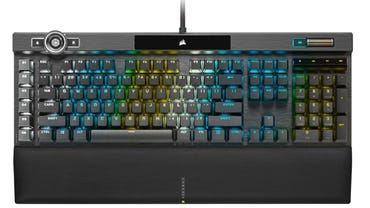
Features
- Form factor – Full-sized+
- Connection type – Wired (USB-A)
- Available switch types – Corsair OPX (linear optical) or Cherry MX Speed (linear mechanical)
- Hot swappable switch sockets – No
Corsair has been in the mechanical keyboard game for longer than just about anyone else on this list. It’s K100, K70, and K65 lines were some of the best available mech key options, gaming or otherwise, for several years, until the market diversified. Today, their full-featured units remain some of the best on the market for gaming-focused users.
If the Razer Huntsman above is a compact, precision-tuned sports car, the K100 is a Rolls Royce, throwing every single feature a gamer, or non-gamer for that matter, could want into a single board. Its left-side row of additional, customizable macro keys; onboard volume and media controls; and unique iCue wheel provide far more control options than any standard keyboard layout ever could. Better yet, these features are all packed in a case that could be used to demolish a wall, thanks to its sturdy metal casing and rock-solid quality.
While some FPS-focused gamers might not have a use for all of this “extra-ness,” MMORPG players, flight and racing sim fans, and MOBA fanatics will likely love the extra controls and lightning-fast mechanical or optical switch options. The only reason not to use this board is if your desk or mousing area can’t handle its ample footprint.
Pros
- Built-in iCue control wheel, media controls, and macro keys provide endless control options
- One of the most advanced, per-key RGB lighting systems, even allows for customized animations
- Included wrist rest improved ergonomics for gamers and typists
- Metal shell can stand up to all but the most overblown gamer rage
Cons
- It’s big, real big
- No clicky or tactile switch options
- On the pricey side for a mass-produced board
Keychron K1 SE
Best low-profile mechanical keyboard: For those that prefer that laptop-style feel
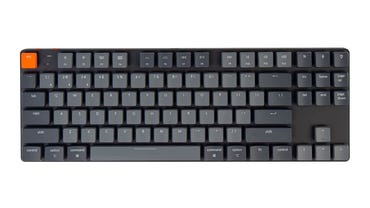
Features
- Form factor – Low profile tenkeyless
- Connection type – Wireless (Bluetooth) or Wired (USB-C to USB-A)
- Available switch types – Blue (clicky), Brown (tactile), Red (linear) “Banana” (early bump tactile), or “Mint” (heavy early bump tactile)
- Hot swappable switch sockets – Yes
The nearly ubiquitous presence of laptops and Chromebooks in school classrooms means that many of us are now learning to type on their very flat included keyboards. This has created a whole class of user that continues to prefer that same low-profile typing feel, even when using a discrete keyboard. To fill this niche, many manufacturers have begun creating low-profile mechanical keyboards. Unfortunately, most of these offerings are either limited to a single, permanent switch or, at best, one of the three standard switch types: Blue (clicky), Brown (tactile), or Red (linear).
Keychron once again makes its way onto our list by creating a board that offers the low-profile form factor, but still includes the rare benefit of having hot swap sockets built in. This means that you can choose a wide variety of switches, like the “Banana” and “Mint” options mentioned above, or any of the growing number of low-profile mech key switches being produced.
The K1 SE combines this unique flexibility with nearly all of the benefits of the K8 mentioned above, including RGB lighting, wireless connectivity options, and a surprisingly sturdy build quality for its very reasonable price point. The result is a rare product that requires very few compromises to achieve the slim, low-profile form factor many typists now prefer.
Pros
- Slim build means it’s barely taller than most laptops
- RGB backlighting can go from flashy to subdued, or off entirely
- Connectivity options make it compatible with nearly any device, even tablets and smartphones
- Hot swap sockets support easy switch replacement and experimentation
Cons
- Low-profile body does limit available switch and keycap selections somewhat
- Slim build means the battery is half the size of the K8’s
- Some typists might find the shorter travel distances of the low-profile keys more fatiguing
Massdrop ALT and Massdrop Ctrl
Best upgraded mechanical keyboard: For more serious hobbyists
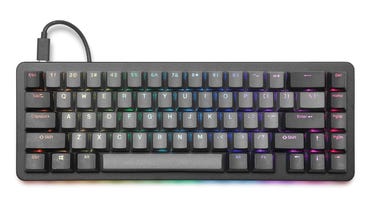
Features
- Form factor – Tenkeyless or 65%
- Connection type – Wired (USB-C to USB-A)
- Available switch types – Halo Clear (tactile), Halo True (light tactile), Kaihua Speed Silver (linear), Cherry MX Blue (clicky), Cherry MX Brown (tactile)
- Hot swappable switch sockets – Yes
Drop (formerly Massdrop) is a company that began its life specializing in the type of group buys that continue to power much of the production in the modern mechanical keyboard hobbyist community. However, it has grown over the years to produce many popular products of its own across the audio and mechanical keyboard spaces. Two of the most well-known of these in-house products are the Drop ALT and Drop CTRL mechanical keyboards.
The CTRL is a familiar tenkeyless option while the ALT is a non-standard 65% board with a unique layout that manages to maintain almost all of the keys you’ll need for heavy text editing, without taking up much more space than a 60% board. Both feature exceptional build quality, including their machined aluminum cases; bright, built-in, per-key RGB lighting, unique RGB edge lighting; excellent shine-through keycaps; and reliable hot swap switch sockets. Both units are also extremely customizable upon initial purchase, with flat and high-profile case options in Black or Space Gray colorways, as well as the widest selection of available switches of any board here.
More importantly for hobbyists, the boards are a joy to work on, with just a few well-machined screws giving you access to the simple-but-flexible internal workings. This makes them a great platform to experiment with things like replacing key stabilizers, adding sound dampening, or even tweaking the internal lighting. Switch collectors will also love the included cap and switch puller, which are some of the nicest and most effective I’ve ever tested. These aren’t the cheapest options on the list, but they might be the best for those that are certain they’re going to dive a little deeper into the hobby. Drop even offers replacement cases for those that want to change the look of their boards entirely.
Pros
- Lighting is some of the richest, most customizable I’ve tested
- Keycaps are popular enough that Drop started selling them separately to meet user demand
- ALT’s 65% form factor is uniquely versatile for such a small board
- Great learner boards for those more serious about the hobby
Cons
- Detachable feet provide only one level of height adjustment
- Can have issues with some extremely long USB cables due to power requirements
- Rim lighting could be diffused better
How did we choose these mechanical keyboards?
As mentioned earlier, we focused on mechanical keyboards that could be readily purchased from major retailers, were in stock most of the time, and represented one of the best options out there for a given type of user. Any keyboard on this list will be usable by any office desk jockey or gaming aficionado. But, some will suit one or the other better thanks to lighting and switch options, available software and macros, and their general aesthetics.
Whichever you choose, rest assured that it was compared to numerous competing offerings to find the best, most cost-effective option in a given space.
What is the best mechanical keyboard?
This depends primarily on two factors: What your primary use for the keyboard will be, and how much desk space you’ve got.
|
If you are… |
Then choose… |
|
If you’re interested in having a top-notch mechanical keyboard but don’t want to break the bank |
Consider the Keychron K8 Wireless. It’s the ideal entry point to the mechanical keyboard hobby and is good for gamers, typists, and hobbyists alike. |
|
If you’re, first and foremost, a gamer |
I’d recommend taking the closest looks at the Razer Huntsman Mini or the Corsair K100 and choosing between the two based on whether you’d rather have more free desk space or a wider array of available macros and controls. |
|
If you’re primarily a typist dealing with large amounts of text entry |
I’d focus on the Keychron K8 or Drop CTRL. Both options offer every key you might need in a size that will fit nearly any desk and build quality that should last you many years. |
|
If you fall somewhere in between the above two types |
You’ve got your choice of options across the whole list. Non-gaming mechanical keyboards can still do a highly-admirable job at serving you well in-game, even if they lack a few extra macro keys. Likewise, gaming keyboards won’t explode if you use them to tap out a research paper or fill in a spreadsheet. Their switches and build quality make them just as adept at these tasks as they are at helping you land headshots and take down raid bosses. |
Which key switch is right for you?
This can be decided based on a combination of what your most common use case for a keyboard is, as well as your personal preference for typing feel. I’ll explain each of the three main switch types, and who they’re generally considered best for, briefly.
|
Clicky switches |
Typically blue, these switches make an audible click when they reach their actuation point. They were initially the most popular switches among many manufacturers, but fell out of favor due to some users finding their incessant clicking an annoyance to themselves or their house/office mates. Still, some prefer the rhythmic sounds of typing or the audible assurance these provide. They’re equally well-suited to gamers or practical typists. |
|
Tactile switches |
Typically brown, these keep the tactile sensation of the clicky switches above, but purposely dampen the noise. That said, they’re still louder than the linear switches below. Some prefer the surety of the tactile “bump” denoting the actuation point, while others find the sudden increase in keypress resistance jarring and disruptive. Many practical typists prefer tactile switches as the “bump” can sometimes prevent accidental keypresses, reducing typos. While some gamers do enjoy the surety of feeling the actuation point, others don’t appreciate the slow-down that tactile bump adds to their keypresses. That extra moment of key travel can often be the split-second difference between in-game life and death. |
|
Linea switches |
Typically red, these switches are pure up-and-down. There’s no audible or physical indication of their actuation point, providing the smoothest operating experience of any switch here. This smoothness and speed has made linear switches the go-to choice for many gamers interested in reducing their reaction times to the bare minimum. For that same reason, some serious typists avoid linear switches due to their tendency to introduce unintended errors thanks to their generally lighter weight and unrestricted travel. |
It’s worth noting that all of the above statements apply most aptly to the standard clicky, tactile, and linear switches that ship with most boards. These switch designs, and their semi-standard color-coding are all based on designs originated by German switch maker Cherry. It still creates versions of all three, as well as far more exotic variants. Many other manufacturers also create countless variants with higher actuation points, heavier or lighter springs, unusual case and stem materials, and more.
Ideally, if you’re ever considering a new switch, try to buy one, or just a few, to test the feel before you commit to enough for a full board. The same goes for any pre-made boards with pre-installed switches you can try before you buy as well.
Is wireless connectivity OK for gaming?
This is a more nuanced subject that it might seem at first. Wireless keyboards that rely on Bluetooth (as well as other peripherals that rely on it) can suffer from latency. This means any command entered on them will be delayed, usually by about .2 seconds or less. Wired keyboards don’t suffer from this delay, meaning that commands are registered almost instantly.
In an ideal world, any keypress during a game will be instantly recognized to give the player the minimal amount of delay before that life-saving jump or vital crouch is registered. While Bluetooth might get you close enough to instant for more casual games, I wouldn’t recommend it for competitive shooter games and high-pressure MMORPGs. Thankfully, many wireless keyboards also offer a wired mode for just this reason.
The only exception I’d make for using a wireless gaming keyboard is if the board in question used 2.4GHz wireless, like some options from Logitech. These dongle-based wireless connections offer far lower latency, and can be just as ideal for gaming as high-end wireless mice have become.
What parts of a mechanical keyboard can you modify?
Short answer: all of them.
Longer answer: the most common would be the key switches and keycaps. Both of these can completely change the feel of a board and, if you have hot swap sockets in your board, both can be swapped out with no more difficulty than unplugging a USB cable and plugging in a new one.
More exotic mods can include things like replacing the stabilizers that help keep longer keys (space, shift, enter, etc.) level while travelling, as well as adding sound dampening foam or silicone. Just about every moving part can also be lubricated to make it feel smoother and to dampen its sound a bit. The possibilities are nearly endless when you start to get into all of the available switches, caps, case options, and unique parts being created for mechanical keyboard modding today.
Are there alternative mechanical keyboards worth considering?
Below are some other mechanical keyboards to consider.
Logitech G413 TKL SE Mechanical Gaming Keyboard: An option from one of the world’s biggest gaming peripheral makers. Its a barebones board that does just about everything well, but its limited by Logitech’s proprietary switch selection. Still, its a great option for the Logitech Devotees.
Corsair K60 RGB Pro Mechanical Gaming Keyboard: A more budget-friendly entry from Corsair that skips the tank-like construction of the K100 in favor of an aluminum top plate. It also lacks the more advanced media controls and iCue dial, but saves a considerable amount of money.
Glorious Modular Mechanical Keyboard Pro: Another option for a hobbyist entry board from a smaller brand. It offers a few extra features the Drop models above lack, but suffers from more stock issues and features a gasket-based build that will be more polarizing thanks to the softer typing feel it provides. Users will also have to buy switches separately if they purchase it from some third-party retailers that only sell the bare-bones version.
Also check out: Best keyboard | Best gaming keyboard | Best ergonomic keyboard




















